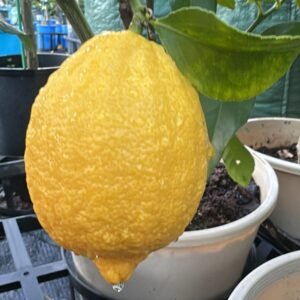The Citrus maxima, commonly known as the Pomelo or Pummelo, is a magnificent and ancient citrus fruit that is a delightful addition to any warm-climate garden. It grows on a medium-sized evergreen tree with a dense canopy of glossy, dark-green leaves. The fruit itself is the largest of all citrus, often the size of a cannonball, with a very thick, smooth rind. Inside, the pale yellow or pink flesh is less acidic than a grapefruit, offering a wonderfully sweet and refreshing flavour.
Caring for Your Pomelo Tree
- Growing Conditions: Pomelo trees love a warm, sunny spot. They thrive in full sun and are best suited to subtropical and tropical climates, as they dislike frost. They need well-draining, fertile soil.
- Pollination: Most Pomelo varieties are generally self-pollinating, but having other citrus nearby can sometimes increase the fruit set.
- Watering: Water deeply and regularly, especially during dry periods and when the tree is flowering and fruiting. A good layer of mulch around the base will help to retain moisture.
- Feeding: Like all citrus, Pomelos are heavy feeders. Give them a balanced, slow-release fertiliser specifically for citrus in spring, summer, and autumn to encourage strong growth and heavy fruiting.
- Pruning: Prune young trees to establish a strong framework. Once mature, prune after the main harvest to remove any dead or weak wood and to maintain a tidy shape.
Usage and Harvest
Pomelos typically take a long time to ripen and are ready to harvest from winter to early spring. You’ll know they are ready when the skin is fully yellow and they feel heavy for their size. The thick rind is easily peeled, and the segments are lovely for eating fresh. The flesh is fantastic in salads, desserts, and cocktails, offering a mild, sweet, and unique citrus flavour.













